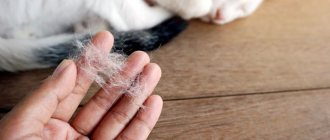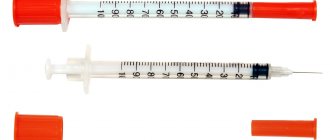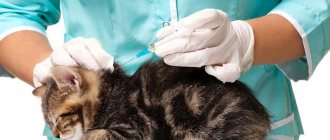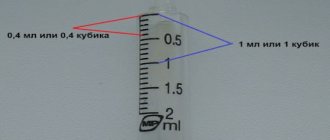When it is difficult for a cat to take a pill, an introducer will help. Thanks to the tool, there is no need to squeeze your fingers into your pet's mouth to place the medicine on the root of the tongue. Calm cats take medications normally. They adapt to evil animals so that the process is successful and without injury. A couple of simple steps will help. The instructions will tell you how to take the medicine correctly - whether the bitter tablet can be crushed or whether it needs to be consumed entirely.
Step-by-step procedure
If this is your first time giving your cat a pill, you need to have at least a rough idea of how this procedure goes. It is advisable that you have an assistant who carefully but firmly holds the cat. Later, after acquiring a certain skill, you will learn to give medicine to your cat without outside help.
First stage: preparation
Wait until the cat is in a calm mood. Caress her and calm her down. Ideally, the animal should be sleepy - then it will resist less.
If your pet has a temperament, wrap it in a thick towel - this way you will avoid scratches and even bites. Scratches are not so bad, but bites are very painful and take a long time to heal.
Open the tablet away from the cat so that it does not become nervous beforehand. Don't prepare in front of her.
Stage two: medication administration
Carefully open the cat's mouth and place the drug there. Make sure the animal swallows it. If your cat keeps spitting out liquid medicine, adjust it to allow for spillage, that is, give a little more than the veterinarian prescribed. The cat will swallow some of it, and some will have to be wiped off.
Third stage: removing aftertaste
Don't let your cat go right away; she may need help. If the drug was in solid form, pat the animal's throat and give some water.
Bitter suspensions and liquids cause severe salivation. In this case, you can give the cat sweetened water to remove the bitterness. Not all drugs can be used for this procedure, so consult a specialist in advance.
You definitely shouldn’t give treats: you can do that later. It is better to distract the cat by playing or leave him alone - perhaps he will want to wash himself or lie down.
Morally preparing the cat for the procedure
Preparation consists of securing the animal so that it does not injure you during the procedure. This can be done in different ways.
One option: wrap the cat in a blanket or thick blanket, similar to swaddling a baby. It is possible, especially if long-term treatment is required, to sew something like a cone from dense fabric with a hole in the upper part - only the animal’s head should fit through it.
Such a cone is put on a cat. Her paws are fixed inside, and her head remains free.
Another option: sit the cat on a soft pillow. In this case, you will have to hold the animal with your hands by the front legs. And the hind legs will “sink” into the pillow and the cat will not be able to scratch you with them.
The choice of how to restrict the animal's movements is up to you. The main thing is that it should not cause pain to your pet. It is better to give medicine together: alone you will not be able to handle both holding the cat and giving it medicine.
Precautionary measures
Real disaster can happen if you don't take precautions. Here are the basic safety rules you should follow:
- It is better to carry out the admission procedure together; call your loved ones or friends for help. One person will hold the purr, and the second will give the drug.
- Try to compress the entire process as much as possible in time. After all, the longer you torment your pet, the more aggression she will accumulate.
- We advise you to prepare the remedy away from the eyes of the purr, otherwise she will sense something is wrong and hide from you as far as possible.
- If you do the whole procedure alone, it is important to secure the paws with claws in a towel. This way, your pet will not have the opportunity to harm you.
Video: how to give a pill to a cat?
I have prepared several videos for you on how to feed a cat a pill. This way you can quickly understand the intricacies of this procedure and give your pet medicine without unnecessary stress for him and for you.
The main thing to remember is that your calmness is the key to the fact that the cat can easily eat the pill. You should not create unnecessary stressful situations, hold the cat when it is hysterically trying to escape, shout at it or force the animal’s mouth open. Using the tricks that I have given in this article, you can give your cat medicine quickly and without problems. And let your pet be healthy!
***
Meow everyone,
Kat Molly.
How to give a cat a deworming tablet
Now you can buy any anthelmintic drugs in veterinary pharmacies. Medicines differ in composition, dosage, and release forms - these are tablets, pastes or suspensions.
The hardest thing is to give cats pills. There are several ways to simplify this procedure.
Stimulation of the swallowing reflex
Stimulation of the swallowing reflex is necessary so that the cat does not spit out part of the medicine, and the medicine in the correct dosage enters the body.
To trigger the swallowing reflex, you must:
- After the medicine has entered the cat's mouth, you need to hold its jaws with one hand, and with the other, simultaneously stroke the throat area from top to bottom.
- If the tablet is given whole, you need to open the mouth with one hand, and with the other, push the medicine to the root of the tongue. These manipulations should be performed carefully so as not to induce vomiting. Then cover the pet’s mouth with one hand, and stroke the throat with the other.
With a piece of butter
Some deworming tablets cannot be split into pieces and must be swallowed whole. To make the tablet slip down the cat's throat faster, you can lubricate it with butter.
Disguise as food
To make it easier to take the medicine, they resort to a cunning trick - they feed the tablet along with food. Ways to disguise tablets:
- The drug is crushed and combined with feed.
- Large tablets are divided into parts and given along with sausage or other food.
It is necessary to ensure that the cat eats the food completely, only then the medicine in the required dosage will enter the animal’s body.
Fixation method (swaddling)
If the cat strongly resists and does not allow the anthelmintic to be administered, you will have to restrain the animal during the procedure. To do this you will need a sheet, diaper, blanket or large towel. The pet is carefully swaddled, with the front legs pressed to the body.
The hind legs should also be secured with cloth. In the neck area, you need to leave a place free from the diaper so that the cat can swallow the medicine.
It is most convenient to carry out the procedure with an assistant, then one person will hold the cat, and the second will feed the tablet. The owner sits the animal on his lap, slightly tilts the pet's head up and opens its mouth.
The tablet should be placed at the base of the tongue. Next, the animal’s jaws are lightly pressed to evoke a swallowing reflex.
Using a syringe
You can give medicine to your cat using a syringe dispenser without a needle. The process of administering the drug is simple:
- The tablet is ground into powder and mixed with water or milk.
- The resulting mixture is drawn into a syringe.
- The cat is seated on the owner's lap, with its back to him.
- The animal's head is tilted upward. Pour the medicine into the cheek, into the gap between the back teeth.
- After infusion of the drug, the swallowing reflex is stimulated.
Using a piller (tablet dispenser)
You can feed the tablet to your cat using a piller (a special device for administering medication). Externally, the device resembles a syringe with a rubber tip into which a tablet is inserted.
The operating principle is as follows:
- open the animal's mouth;
- push the piller to the root of the tongue;
- press the piston, thereby squeezing out the tablet;
- cover the mouth and wait until the animal swallows the medicine.
The peeler is a convenient device that protects the owner’s hands from the sharp teeth of an obstinate pet.
Security measures
Worms occur not only in stray cats and animals that walk on the street. Infection with internal parasites can occur even if the pet does not leave the apartment.
Methods of infection by helminths:
- parasites are transmitted from cat to kitten;
- carriers - other animals living in the house;
- helminths can be brought by people on shoes and clothes;
- consumption of contaminated raw meat and fish;
- fleas and ticks are often carriers.
If your cat shows symptoms of helminth infection, you should immediately contact a veterinarian - he will examine the pet and prescribe medications for treatment.
Cats need to be dewormed once every 3-4 months. The very first procedure is performed on a kitten before vaccination.
Regardless of the type of anthelmintic agent, two basic rules must be followed:
- Follow the instructions for using the medicine.
- Calculate the dosage in strict accordance with the weight of the animal.
You should not often give your cat anthelmintic medications so as not to harm its health.
After the procedure, you need to monitor the pet's condition. At the first sign of discomfort, you should contact your veterinarian.
Syringe manipulation
It often happens that a cat is cunning: it eats the food, but the tablet remains in the bowl. In these cases, you can dissolve the tablet in water and use a syringe to inject the medicine into your mouth. This is only suitable for drugs that are approved for mixing with liquid. In this case, you need to monitor the injection dose. It's better to limit yourself to a drop. After all, after strong pressure, the cat will have an aggressive reaction, and it will spend all its energy on escaping. Accordingly, some of the drug will spill, but it is unlikely to be able to calculate how much of the drug got inside. This method is not suitable for medicines with a bitter taste. Once inside, the tablets provoke salivation, which means that a certain part of the medicine will come back out.
If the cat does not eat dry food, you can do the same with liquid food. You should fill only part of the bowl, place the medicine there, watch how the cat empties the contents and then fill the bowl to the optimal level.
What devices can you use?
To speed up the cat's intake of tablet medications, veterinarians recommend using an introducer. The tablet dispenser greatly simplifies the process of consuming whole tablets, especially if the animal is aggressive. For medications that can be crushed, you can use a medical syringe without a needle. Crushed human medicines are mixed with liquid. They need to be pushed into the cheek part. If you don’t have any equipment, you can use the handle of a spoon or a coffee spoon, which, unlike a tea spoon, will not be too big for the cat’s mouth.
What is important to consider when giving your pet medication?
Giving tablets, capsules, powders and mixtures seems much easier than giving a cat an injection. In reality, everything is not so simple. A cute pet will definitely remind you that it has teeth and claws.
Giving medications orally (orally through the mouth) must be done correctly:
The best position for administering the drug is when the animal is sitting or in the sphinx position. This reduces the risk of medications entering the respiratory tract. Crushed pills and powders should not be poured dry into the animal’s mouth.
High risk of suffocation. It’s a good idea to ask your veterinarian whether a certain drug can be given with food, dissolved in a liquid, or ground into powder. It is important to monitor the dosage. Especially in kittens, who are often prescribed a certain proportion of one tablet. It is strictly forbidden to give liquid medicine to cats lying on their back. When a cat is given a bitter or sour drug, foam may form in the mouth and excessive salivation may occur.
It's not critical. But next time it is better to choose a different method.
You cannot give your pet suspensions, solutions, dragees, capsules, syrups, mixtures on your own in the following cases:
- vomit;
- difficulty breathing;
- damaged neck muscles and skull bones;
- intestinal obstruction, constipation for many days, when there is a risk of complete blockage of the intestine or when a foreign body is suspected;
- painful lesions in the oral cavity.
What should you do if your cat struggles, resists, and spits out the medicine?
If the cat actively resists, the owner is not always able to give him deworming medicine or another drug. After repeated feeding attempts, the tablet still ends up on the floor, the pet scratches, resists, bites, and spits out the medicine. In such situations, you can seek help from a veterinarian or take advice from specialists. You can watch training videos on how to properly restrain an animal and give medicine.
How to restrain a four-legged patient?
It is sometimes difficult to restrain a cat on your own, so experts recommend doing it together with a family member. One person holds the pet, and the second wraps it tightly in a blanket, blanket, towel or other material. The assistant then holds the wrapped cat while the owner feeds the pill to it without fear of resistance.
Another method of fixation also involves the participation of two people. The assistant must take the animal by the withers and hold its paws with the other hand. In this position, the cat will not be able to escape. The owner opens his pet's mouth and places the tablet on the root of the tongue.
How to get a cat to swallow the drug?
Just because a tablet is in a cat's mouth does not mean that he will swallow it. Many pets keep bitter pills in their mouths until they are released. Once free, they spit out the pills. If the owner notices that the medicine has not been eaten, the procedure is repeated. However, sometimes pets manage to get rid of the medicine unnoticed, which complicates the situation, especially when the drug is given not for prevention, but for therapeutic purposes.
To ensure that the cat swallows the medicine after it gets into her mouth, you need to place the tablet on the root of the tongue, and then hold the stubborn patient's jaws closed for a few seconds. In this case, you can try to evoke a swallowing reflex by blowing into her nose or stroking her neck from top to bottom. After the procedure, you should not let the cat go without examining the oral cavity; you need to make sure that there are no tablets in it.
Puncture of the maxillary sinus
Practically not used in modern otorhinolaryngology. For acute bacterial sinusitis, systemic broad-spectrum antibacterial drugs are indicated, which successfully cope with the bacterial process without punctures and “cuckoos”.
Punctures for a bacterial process in the maxillary sinuses are mainly indicated if culture of the sinus contents is needed - usually when 1-2 courses of antibacterial therapy are ineffective.
Very rarely, such punctures are performed for diagnostic purposes, when it is not possible to perform radiography or computed tomography of the paranasal sinuses. Another indication is severe pain associated with the pressure of the contents on the walls of the sinus. The puncture is done once during the main treatment. Several punctures are indicated only in the case of a persistent bacterial process with two or more courses of antibiotics, and there is no possibility of performing endoscopic surgery on the sinuses.
It has been proven that puncture of the maxillary sinus does not speed up the healing process.
It is important to know : puncture, like any invasive method, can have complications, including trauma to the medial wall of the orbit, nasolacrimal duct, soft tissues of the cheek, and nosebleeds.
In what form should the tablet be given?
In their “love” for this method of treatment, the little brothers are very similar to small children. It is impossible to explain to them that a tasteless capsule is good for health. But, unfortunately, even simple prevention against worms will not do without them.
Before giving your furry pet anything from the pharmacy, you should understand how the drug works.
Read the instructions for use carefully, pay attention to the dosage, how many times a day you need to take it, and also at what time (before or after meals). If after reading you still have questions, you need to ask your veterinarian, or at least find answers on the Internet
There are medicines coated with a special coating. Their goal is to act only some time after entering the body. Such preparations should never be crushed, crushed or separated, otherwise they will lose their properties. Also, if you don't feel confident enough, call someone to help you, and bring a couple of towels just in case.
Often, owners are afraid that the process of taking medications will turn into a complete nightmare. Therefore, professional veterinarians often recommend one of four simple methods.
Trick #1
Ask your doctor if you can mix the medications he or she prescribes with food. There are a number of drugs that lose all or part of their properties if mixed with anything. But if your medicine is not on this list, take a small piece of raw minced meat, meat or any other food that your cat likes. Grind the pill into powder and add to food. This method is very simple. The pet will receive both treatment and a favorite treat as a reward
The only thing worth paying attention to is the serving size of the food. The piece should be of such a size that the cat does not notice the unpleasant taste, but can eat it all in one go.
Trick #2
There is another simple way to give the tablet to a kitten or adult animal. Grind it and then mix with a drop of sour cream. Apply this mixture to your baby's nose. He will feel the sour cream on his nose and lick it off along with the drug. You can use any creamy treat, and if the powder is bitter, then it is acceptable to use something sweet: yogurt or buttercream. Remember that the sweet option is not suitable if you are treating a cat
Trick #3
If you cannot mix medications with food, and the animal refuses to swallow the capsules whole, there is another simple solution. First you need to crush the tablet, then mix it with a small amount of water. Now draw in the resulting liquid using a syringe. The main thing is not to use too much water so that your pet does not choke.
2-3 ml is enough for the powder to completely dissolve in it. Now you need to pour this mixture into the animal. Take your pet on your lap and open its mouth slightly with your thumb and index finger. With your right hand, take the syringe and gradually inject its contents into your open mouth.
Do not pour it all out at once, otherwise the liquid will simply leak out. Once the syringe is empty, allow the cat to close his mouth and lift his head slightly so that he swallows the liquid. Do not use this method if you are not sure that the drug can be mixed with water.
Trick #4
There are cases when it is strictly forbidden to mix the product with water or food. Or, for example, the doctor prescribed not pills, but capsules that cannot be opened. Then another time-tested method comes to the rescue.
Place the cat on a high place: this could be a table, sofa or other furniture. Then secure the animal with your left hand so that it does not run away, and use the fingers of the same hand to open its mouth. If possible, quickly place the drug on the root of the tongue as deeply as possible and allow the animal to close its mouth.
Now lift your chin slightly and massage your throat from top to bottom to provoke the swallowing reflex. Ready! Watch the patient a little: some particularly resourceful ones may spit the pill back out, and then you will have to repeat the procedure.
These methods are quite effective. Of course, there is an option to purchase a special device at a veterinary pharmacy - an introducer, or a tablet dispenser in the Russian style. But most tablets can be given using the first three methods, causing little or no discomfort to the cat.
Recommendations from veterinarians
Taking medications is in any case stressful for four-legged pets. Therefore, many owners remember previous illnesses with fear, because cats actively show aggression and categorically refuse medications. However, veterinarians give owners the necessary advice that will help greatly simplify this procedure.
- Do not yell at your pet under any circumstances, as this will not make the process any easier. The fact is that animals do not understand human language, and he will not understand you anyway; from such actions he will only experience even more stress.
- Taking pills out of the package in the presence of a cat is not the best thing to do. After all, cats remember the actions of their owner, and they can remember that the last time he was severely tormented after this. Therefore, he will try to hide from you better.
- Cases of injury cannot be excluded, because your cat may bite or scratch you. Therefore, we recommend that you keep a piece of cotton wool soaked in hydrogen peroxide at the ready.
- If you need to regularly give tablets to your pets, then try to do it confidently and quickly. Then the cat will get used to such procedures, and each time he will react calmer.
- If you can’t persuade your cat to take a vitamin, then you should talk to your veterinarian. After all, you can simply choose a different way of taking medications. After all, they can be produced in the form of pastes, suspensions or solution for injection.
- Remember that your pet's comfort is important, so we recommend placing your pet on a table. For comfort, you should lay a soft blanket on it.
Getting a cat to take medicine is not that easy in reality. If you read the article carefully, then you know how to give a pill to a cat if he spits it out. Whatever method you choose, the main thing is calm and self-confidence. The cat will sense your mood and will resist less. Good health to you and your pet!
Don't forget to leave a comment which method worked for you?
Is it possible to mix medications and food?
When a cat refuses to take medication, many owners mix the medication into her food. However, this cannot be done for a number of reasons.
Firstly, not all medications can be added to food. Some medications must be taken on an empty stomach. In addition, there are veterinary drugs that are available in the form of capsules or coated tablets. They cannot be crushed into pieces or crushed.
Secondly, some medicines have an unpleasant taste. Cats have well-developed taste buds and sense of smell. If you hide the pill inside a piece of food, your pet will eat the food but not touch the medicine.
Thirdly, medicine mixed into food may not have the desired effect. A cat may start eating food along with the drug, but then quickly move away from the bowl, feeling a strange taste. You will not have the opportunity to check what dosage of the drug the animal has taken.
Fish and 9 other products that can replace masks and hair conditioner
Labeling makes it impossible to counterfeit Sputnik V vaccines
Doctor Alexander Myasnikov told Russians about products for longevity
Carrying out the main procedure
After the cat was immobilized, all that was left was to give her an anti-worm tablet. If you have an assistant, then there should not be any special problems, but when you carry out this procedure yourself, certain difficulties are possible. First of all, this is due to the fact that you must have both hands free. To do this, the animal, wrapped in a blanket, blanket or towel, should be placed on the floor and pinched with your knees. At the same time, his head should be directed towards you.
Your hands are free, now you should open the cat’s mouth
Carefully lift her head with your left hand (if you are left-handed, then with your right) and place your index finger on her forehead. In this case, the remaining fingers should be located along the animal’s cheekbones
We move the tips of the index and thumb to the pet’s upper jaw and place them on both sides. Now we lift the animal’s head to the ceiling with our fingers - the mouth will open slightly. At this moment, you need to move your fingers a little inside the mouth so as to move the cat’s lip towards the teeth. As a result, she will lower her lower jaw on her own and in the future will not close her mouth so as not to bite her lip.
If the goal is to give a pill, then the mouth should be open quite wide; in the case of liquid in a syringe, the mouth can be opened only slightly
If the medicine is in tablet form
- So, opening the cat’s mouth, place your index finger between the fangs and press lightly. We hold it in such a position that the animal cannot close its mouth.
- Throw the tablet as far as possible - preferably so that it ends up on the back of the tongue. In this case, the cat will not be able to push the medicine out, and the muscles of the tongue during such an attempt will only push it further into the throat.
- If you are sure that the tablet is far enough away, release your mouth - the cat will close its mouth and swallow the medicine for sure. Otherwise, you should help the animal by holding its mouth closed until you feel that the cat has made several swallowing movements.
Sometimes pets resist and do not want to swallow the tablet, continuing to keep it in their mouth. And to trigger the necessary reflex, just blow into the cat’s nostrils or stroke its neck. After she has taken a few sips, release her mouth and check to see if the pill has actually been eaten. Finally, offer the animal water and feed it - this will allow the drug to pass through the esophagus faster.
It’s very good if you have a pill dispenser in your first aid kit. This is a special tool that significantly facilitates the administration of solid drugs and saves in situations where the owner is simply afraid to insert his fingers into the pet’s mouth. To carry out the procedure, you need to place the medicine in the tablet dispenser, open the cat's mouth and bring the end of the instrument to the back of its tongue. We press the button and the tablet falls out and ends up right in the animal’s throat.
If the drug is liquid
How to give a cat medicine from a syringe? This is somewhat simpler than in the case of tablets.
- We open the animal's mouth slightly - just enough to fit the syringe into it.
- We insert the syringe with the medicine into the mouth, bringing it as close as possible to the inner surface of the cheek.
- We press the plunger, squeezing the drug out of the syringe, stopping from time to time so that the cat can swallow the resulting portion.
It is very important to perform this procedure slowly and not allow the mouth to overflow with liquid.
After the medicine in the syringe runs out, take it out of the mouth and release the cat.
How to protect yourself
Unfortunately, it is impossible to explain to the pet that the medicine is given for its benefit. To avoid bitten hands and a scratched face, take care of your safety in advance.
- Fix the animal in one position. Some breeds are characterized by increased aggressiveness or large size - for example, Bengal or Maine Coon. In this case, you need to do the procedures while standing, pressing the animal’s head against the thigh or a flat surface, for example, a wall. This fixation will protect you.
- Wear thick gloves - for example, fabric ones with rubber on top, so that it is not easy for the animal to bite through them. If you don't have gloves, use a thick piece of cloth.
- Some people advise swaddling the animal. This is indeed an effective method, but especially nimble cats can break out of the “cocoon” before you complete the procedure. Therefore, it is better to spend it together.
- The procedure should be quick, and your movements should be confident. Don't give in, cats feel everything.
Friends, I will be glad if you tell me how you treat your four-legged pets. The topic is as relevant and necessary as possible, so I collect such experience and gladly share mine!
The main ways to give deworming tablets to a cat
Method 1
Irritation of the root of a cat's tongue causes a swallowing reflex.
You need to open the animal's mouth. The medicine for worms should be placed as close to the root of the tongue as possible. Then close your pet’s mouth and hold it for a few seconds. It is important not to press on the base of the tongue, as this may cause backfire.
Method 2
To give your cat deworming medicine, you need to sit comfortably on your knees. Place the animal with its back to itself, so that it does not have the physical ability to escape.
With one hand, tilt the cat's head up, lightly pressing on the lower jaw. The cat will open its mouth. All that remains is to push the medicine as close to the root of the tongue as possible.
Having closed the mouth, be sure to make stroking movements along the pet’s throat from top to bottom. This way the swallowing movement is stimulated. After this, it is worth making sure that he really swallowed the anthelmintic.
Method 3
Before you start giving your cat deworming medicine, you need to sit him on your lap facing you. A distraction will be the stroking movements of the abdomen. At this time, the pet relaxes, and the desire to slip out of the owner’s hands disappears.
With your left hand, the cat's head is thrown back, at the same time the jaw is unclenched by applying firm pressure on the base of the jaw. With your right hand, the tablet is pushed closer to the root of the tongue. To stimulate the swallowing reflex, you need to carry out movements directed from top to bottom along the animal’s throat. After the cat makes a swallowing movement, it is necessary to check for the presence of the tablet in the mouth.
Method 4
Using a peeler. A piller is a design that looks like a syringe. With its help, you can easily and quickly give your cat medicine. To use this device to feed a deworming tablet, you need to:
- Place the medicine securely in the rubber tip.
- After opening the cat's mouth, place the tip with the medicine as close to the root of the tongue as possible.
- By confidently pressing the piller piston, push the drug into the animal’s mouth.
- Get the peeler.
- Close the cat's mouth.
- Stimulate the swallowing reflex by stroking the throat.
Method 5
If there is no original device at home, and the drug against worms needs to be introduced into the body, the faster the better, then it can be easily done at home.
- Take a syringe. The tablet must match the diameter of the syringe circumference. Typically a 2 ml syringe is used.
- Carefully cut off the edge, preferably without jagged edges.
- Place the medicine inside the syringe.
- Open the cat’s mouth and, placing the “piller” closer to the root of the tongue, squeeze the medicine into his mouth.
When is syringe feeding necessary?
Force-feeding is, to some extent, violence against the animal, but it maintains strength well and provides the weakened body with nutrients. Syringe feeding a cat is recommended in certain situations:
- for long-term chronic diseases, including oncology;
- if severe exhaustion of the animal is detected;
- after injuries, especially to the head, teeth and jaws;
- during the recovery period after surgery;
- in the process of rehabilitation after strokes, paralysis and neurological disorders;
- small kittens aged 3-4 weeks, not yet capable of eating adult food.
Regime and diet. After consulting with your veterinarian, you should create a suitable diet and feeding regimen.
Suitable foods for sick cats include:
- cat pates from jars and bags;
- dry food granules soaked in warm water until thick sour cream;
- baby meat puree.
- what to feed a kitten up to 1 month;
- why doesn't the cat eat anything?
- how to feed a cat correctly.
Grind into powder and add to food
If your cat spits out pills, you can give him the drug this way. He is considered the most humane.
- Place a small amount of food in the cat's bowl.
- Grind the pill, pour the powder into a bowl.
- Mix the food thoroughly and give it to your pet.
If you need to give a capsule, then in this case things are much easier. Since you just need to open the capsule and mix the powder inside with food.
You can use canned cat food, minced meat or pate as food. Dry food is definitely not suitable for this method of medication administration.
Using a blanket
The cat must be wrapped in a blanket, rug or large towel in order to prevent it from moving and to prevent it from being injured by its claws or bitten. Having wrapped your pet, you need to secure it: squeeze it between your legs, kneeling down. Place one hand on the animal's head so that the thumb and index finger are placed on the cat's cheekbones, closer to the mouth. When you press on the cheekbones, the mouth will open slightly and you can put the necessary medicine there.
Typically, drugs are available in liquid or solid form:
- When you use a liquid medicine that is in a syringe without a needle, then the mouth should be opened only a little so that the medicine does not spill out.
- If you need to give a pill to your pet, you will have to open its mouth wide. The medicine must be pushed deep into the mouth so that the cat cannot spit it out, and the animal must not be allowed to open its mouth until it swallows the tablet. If your pet holds the medicine in his mouth, you should blow a little into his nostrils, in this way you will trigger the swallowing reflex.
Give your cat something to drink after she swallows the tablet.
What to feed a sick cat
In the advanced stage of any disease, the cat refuses to eat. There can be many reasons: loss of strength, nausea, pain during chewing, loss of smell, lack of a swallowing reflex, injury or inflammation of the throat, etc. Hunger quickly leads a cat to exhaustion, and if the pet still doesn’t drink, then to dehydration.
Feeding a sick cat requires an individual approach , since you need to clearly understand the needs of the body and adapt to them. Without permanent consequences, a cat can fast for 24 hours, but a noticeable slowdown in metabolism will occur after 12 hours.
Note! A slowdown in metabolism leads to less production of leukocytes and a decrease in the body’s cleansing function... in other words, loss of strength and progression of the disease.
Almost always carbohydrates , since, while fighting the disease, the pet loses weight. It is important not to overdo it, since the body also wastes energy not processing carbohydrates. To help your pet you need to provide him with the most comfortable conditions, warmth and eliminate the need to move around his home.
The type and method of nutrition is selected taking into account the maximum number of consequences of the disease. The minimum that needs to be taken into account is:
- Weakened intestinal microflora - almost always, if a cat has a fever, colonies of friendly bacteria die en masse. Visually this is not noticeable, but the consequences will not take long to appear - the cat will have indigestion. Conclusion - food should be easy to digest.
- Exhaustion - the body of a sick cat throws all its resources into fighting the disease, so the fur, skin, and some mucous membranes are left without the usual nutrition. Conclusion - food should be nutritious.
- Irritation of mucous membranes - in cats, the mucous membranes of the eyes, nose and mouth interact almost instantly, that is, if the eyes, throat and throat are irritated. Many pets refuse to eat simply because they have difficulty swallowing. Conclusion - food should be warm, liquid or crushed and soft.
Emotional mood
One of the mandatory conditions for treatment is to take care of the animal’s emotional state in advance. Before giving a pill to a kitten or adult pet, try to behave calmly and not be nervous. You can simply talk to the animal - the owner’s voice has a calming effect. It is not recommended to chase your pet throughout the apartment; it is better to wait until it comes on its own. It is prohibited to carry out the procedure near the sleeping area, tray or food bowl. Subsequently, the animal will associate them with unpleasant manipulations.
Another requirement is not to call the cat to take the medicine. The animal may decide that the owners are going to feed them, play or just pet them. In the future, the pets will refuse to respond to their owners’ calls.
You should not force an animal to take medicine, especially if a long course of treatment is prescribed. Each time it becomes more and more problematic to give a pill to a cat, so it is recommended to perform manipulations only on a pet that is in a state of calm. If your pet behaves aggressively or restlessly, it is better to postpone taking the drug for a while and repeat after an hour and a half.
X











